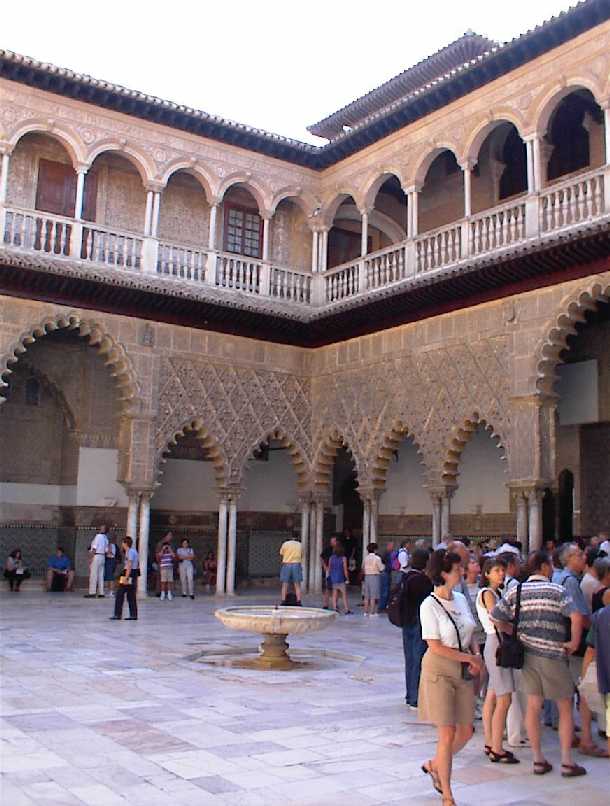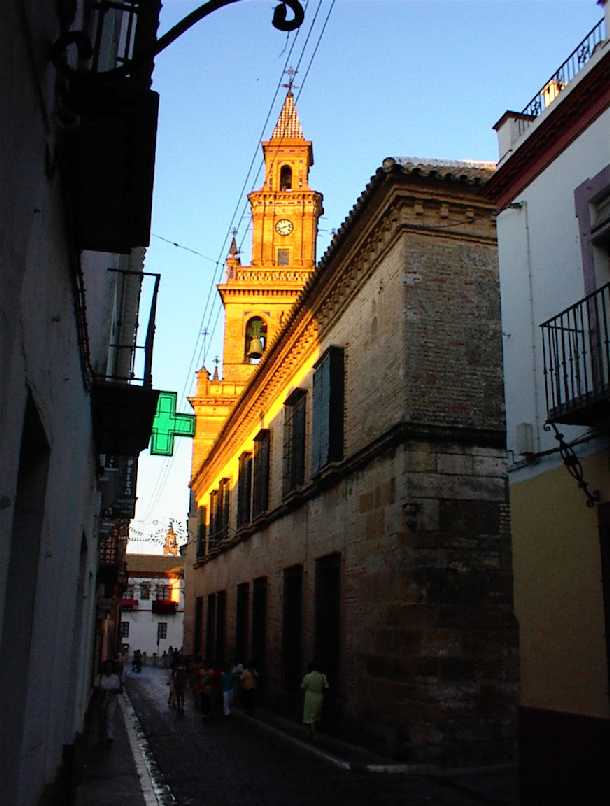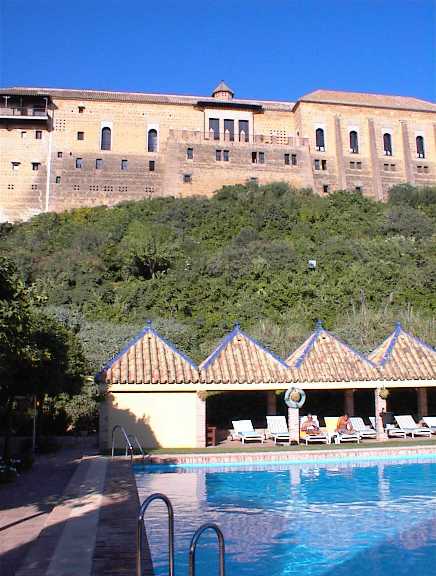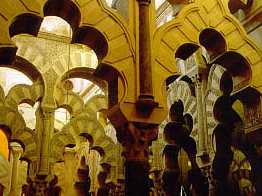Wednesday 8 September 1999
Apart from the Cathedral the Alcazar is Seville's
main attraction. This Moorish palace is one of the largest in its kind in Andalusia. The original building dates back to the 8th century and was built
on the ruins of Roman army barracks. In the 11th century it became the residence
of the Abbadid dynasty. After Seville's reconquesta, it became the residence of
the Spanish court for four centuries and even today the top floor serves the
royal family when they visit Seville. Especially Pedro the cruel (1350-69) left
his marks on the place. Charles the fifth too had major additions built. Right
of the entrance is the Casa del Oceano, where the explorers plotted their
expeditions in the 16th century. The main palace is the Alcazar's pride,
especially the Salon de Embajadores is splendid. The part by Charles V is a bit
dull and full of wall tapestries. The gardens have a lot to offer too. Very
green, fountains and pavilions. After the Alcazar we go and look for an Internet
café. Not as easy as we thought, but we get there in the end. We e-mail our
friends at home. After our siesta we take a cab to the Cartuja, the former
Carthusian monastery of Seville. The monastery was desecrated by Napoleon's
troops. The monks fled to Portugal. After the French left it was turned into a
ceramics factory, which it remained until 1982. It was renovated at great cost
for the 1992 Expo and now serves as a museum, art gallery and industrial
archeological site. There is not much left of the Expo. Most pavilions are still
there, but have been badly neglected and most of them are closed. We walk to Seville's
shopping district around the Plaza del Duque and the Calle Sierpes.
Especially the Calle Sierpes invites us to some serious shopping.
in Andalusia. The original building dates back to the 8th century and was built
on the ruins of Roman army barracks. In the 11th century it became the residence
of the Abbadid dynasty. After Seville's reconquesta, it became the residence of
the Spanish court for four centuries and even today the top floor serves the
royal family when they visit Seville. Especially Pedro the cruel (1350-69) left
his marks on the place. Charles the fifth too had major additions built. Right
of the entrance is the Casa del Oceano, where the explorers plotted their
expeditions in the 16th century. The main palace is the Alcazar's pride,
especially the Salon de Embajadores is splendid. The part by Charles V is a bit
dull and full of wall tapestries. The gardens have a lot to offer too. Very
green, fountains and pavilions. After the Alcazar we go and look for an Internet
café. Not as easy as we thought, but we get there in the end. We e-mail our
friends at home. After our siesta we take a cab to the Cartuja, the former
Carthusian monastery of Seville. The monastery was desecrated by Napoleon's
troops. The monks fled to Portugal. After the French left it was turned into a
ceramics factory, which it remained until 1982. It was renovated at great cost
for the 1992 Expo and now serves as a museum, art gallery and industrial
archeological site. There is not much left of the Expo. Most pavilions are still
there, but have been badly neglected and most of them are closed. We walk to Seville's
shopping district around the Plaza del Duque and the Calle Sierpes.
Especially the Calle Sierpes invites us to some serious shopping.
At night we continue our scan of the gay scene Now it is time to look at the venues around the Alameda de Hercules square.
Thursday 9 September 1999
 It
is time again to leave Seville. We're not going
very far. Only 30km East is Carmona. We will stay at the Parador of Carmona.
This time it is a 11th century Moorish castle beautifully located on a hill top
overlooking the area around. We have a room with balcony and view. The Parador
has a pool. We walk around the town and visit the Roman Necropolis. It is a
roman burial site where the Romans burnt their dead and placed the ashes in
underground columbaria. It was in use from the second century BC until the
fourth century AD. After this macabre but very cultural activity we feel we need
to eat. We have some Mondaditos (small sandwi
It
is time again to leave Seville. We're not going
very far. Only 30km East is Carmona. We will stay at the Parador of Carmona.
This time it is a 11th century Moorish castle beautifully located on a hill top
overlooking the area around. We have a room with balcony and view. The Parador
has a pool. We walk around the town and visit the Roman Necropolis. It is a
roman burial site where the Romans burnt their dead and placed the ashes in
underground columbaria. It was in use from the second century BC until the
fourth century AD. After this macabre but very cultural activity we feel we need
to eat. We have some Mondaditos (small sandwi ches)
and return to the Parador. After a short siesta we make use of the pool. Here we
spend the afternoon in sheer idleness. In the evening we have a delicious dinner
in the Parador's impressive restaurant.
ches)
and return to the Parador. After a short siesta we make use of the pool. Here we
spend the afternoon in sheer idleness. In the evening we have a delicious dinner
in the Parador's impressive restaurant.
Friday 10 September 1999
After the luxurious breakfast
buffet we say goodbye to Carmona and make for Córdoba. We find a hotel in the
middle of the old town near the Mezquita, Córdoba's major sight. The Mezquita
was once of the most important Moorish mosques in Spain. Córdoba was for quite
some time the capital of the western Caliphate (Baghdad of the Eastern). The
Mezquita is an impressive building and in spite of the crowds pleasant to walk
around in. After the reconquest on the Moors the Mezquita underwent some heavy
alterations and was converted into a cathedral. Even so the Islamic roots of the
place are clearly visible. Even the  Mihrab
was spared. Charles V who ordered the works, had regrets when he saw the
results: "You have built something other would have built anywhere, but you
have something unique in the world". The mosque in its turn was built at
the site of Visigoth cathedral.
Mihrab
was spared. Charles V who ordered the works, had regrets when he saw the
results: "You have built something other would have built anywhere, but you
have something unique in the world". The mosque in its turn was built at
the site of Visigoth cathedral.
In the late afternoon we do some walking in Cordoba's old town. Part of the city walls is still in tact. There also a synagogue, one of three in Spain that survived the Inquisition (the other two are in Toledo). We also have a peek in the Callejon de los Flores, the flower alley, a popular object for wedding photographers.
At night we go to a flamenco show at the tabloa
"El Cardenal". It is, we're told, the best tabloa
(flamenco venue) without membership. And we like to believe it! The show lasts
for more than 2hours. It is a great show and the open air patio is packed.
Saturday 11 September 1999
Today we tour around the Campiña Cordobesa, the wine district south of Córdoba. Our first stop is at Montemayor a small village on a hill. We carry on to La Rambla, where a lot of ceramics is being produced. Montilla is the centre of the Montilla industry. Montilla is like sherry a fortified wine. For a long time Montilla wines were marketed as cheap type of sherry. an image the industry has had great difficulty shaking off.. Montilla itself is a little attractive town. The Alvear bodega is unfortunately closed on Saturdays. We move on to Aguilar, where we have lunch. Then we drive onto Lucena. A bit south of Lucena is a mountain with a baroque church on top: Sanctuario de la Virgen de Araceli. The road up is narrow and winding, but the views are very rewarding. The church is frequented by devout people from all directions. In the shop next to the church all thinkable an unthinkable trinkets with the image of the virgin Mary are on display. From ash tray to bed side lamp. We drive back to Córdoba. At night we stroll around the modern part of Cordoba. The Plaza de Tendillas is the centre of it. Not a very beautiful square, but a good vantage point for watching the Cordobese, on their evening parade. Hardly any tourists here, who stick to the area around the Mezquita. We have dinner at Rincón de Chico Medina. After the enourmous salad that serves as a starter I get a huge leg of lamb. The waiter is genuinely surprised when I can not eat it all.